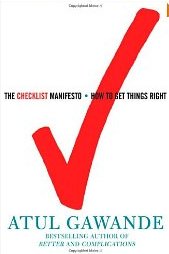Review
The Checklist Manifesto
Correctly applying knowledge to achieve a goal is not automatic; it needs attention and method. In The Checklist Manifesto, Atul Gawande describes two common obstacles to employing available knowledge and demonstrates a corrective method.
One obstacle is that we may forget to perform an important action though we desire to, know the process, and know that it is important. Through routine and boredom, or inattention to precautions, we neglect to do it, or are distracted by the complexity of a situation and lose track, or the knowledge is available to us but we cannot remember it. In such cases, a checklist quickly tells us the critical steps to take.
Airplane pilots were the early inventors of the systematic, and deliberate use of checklists to overcome errors in applying readily-available knowledge. Their efficacy has been repeatedly proved, in the remarkable safety record of modern aviation, including dramatic situations such as the successful landing by Captains Sullenberger and Skiles of an Airbus 320 after both engines were shut down by striking a flock of geese. Checklists have proved their efficacy in fields as divergent as medicine, financial analysis, and restaurant operation.
Sometimes, however, the exact process to achieve a goal is not known, though the knowledge needed to solve the puzzle and discover the process is known, but that knowledge is not all immediately available to one person, but rather parts of it are held by a number of people. In such cases, checklists again play a powerful role because, at the meta level, we do know the process: find the people who have the knowledge, consult and learn from them, and use all that information to arrive at a solution. A checklist of the issues that need to be addressed and the people to consult ensures that we actually perform the process correctly.
In contrast to a "to do" list of things that we intend to do at some point in the future, a checklist is a list of the essential steps that absolutely must not be overlooked in a particular context. Each context, such as preparing a patient for surgery, analyzing a potential investment, cooking a dish correctly, preparing a plane for takeoff, or landing a plane with dead engines, has its own checklist. Checklists are of two types: DO-CONFIRM and READ-DO. With a DO-CONFIRM checklist, appropriate for familiar tasks, performance is from memory and the checklist is used to confirm than no step was missed. A READ-DO checklist gives and verifies the steps of a less-familiar procedure
When used, checklists have reduced deaths from surgical complications by as much as 47%, allowed top businesses to deliver exceptional customer service, and helped outstanding hedge funds to make decisions with lower risk and more profit. Despite the evidence, however, many people are reluctant to use checklists — and that provides an opportunity for superior performance to those who do.
Books
- Getting Things Done, The Art of Stress-Free Productivity by . How to transform mental clutter and stress into a system for objectively deciding how to be most productive.
- The Checklist Manifesto, How to Get Things Right by . Checklists allow one to manage complexity and cognitive overload. Gawande shows, first, that checklists are the means, during complex situations, to consistently apply the knowledge that is available in our minds but that we might forget to use. Second, checklists permit us to manage the assembly and integration of knowledge that is held by different members of an enterprise when facing a complex situation.
Links
- Lisa VanDamme on Checklists for Children – Lisa discovered that checklists take stress out of her children's getting ready for school.
- Signal Charlie – Website devoted to continuous improvement in airline safety.
- The Hidden complexity of Cockpit Operations – This PowerPoint deck, based on NASA research, analyzes the cognitive roots of human error in takeoffs and gives advice on how to organize tasks and checklists to reduce failures. (Hint: Avoid multi-tasking.)
- Thinking Skills – Techniques for improving your cognitive and problem-solving skills
copyright © 2024 Andrew Layman, all rights reserved, 1/15/2024 6:12:50 PM, Topic: The Checklist Manifesto, http://www.strongbrains.com
